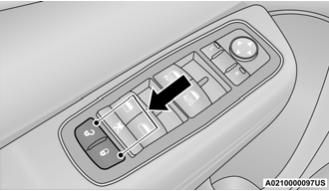Dodge Charger: Head Restraints / Reactive Head Restraints — Front Seats
The front driver and passenger seats are equipped with Reactive Head Restraints (RHR). In the event of a rear impact, the RHR will automatically extend forward minimizing the gap between the back of the occupant’s head and the RHR.
The RHR will automatically return to their normal position following a rear impact. If the RHR do not return to their normal position, see an authorized dealer immediately.
To raise the head restraint, pull upward on the head restraint. To lower the head restraint, push the adjustment button located at the base of the head restraint and push downward on the head restraint.

WARNING!
- A loose head restraint thrown forward in a collision or hard stop could cause serious injury or death to occupants of the vehicle. Always securely stow removed head restraints in a location outside the occu- pant compartment.
- ALL the head restraints MUST be rein- stalled in the vehicle to properly protect the occupants. Follow the re-installation instructions above prior to operating the vehicle or occupying a seat.
- Do not place items over the top of the Reac- tive Head Restraint, such as coats, seat covers or portable DVD players. These items may interfere with the operation of the Reactive Head Restraint in the event of a collision and could result in serious injury or death.
 Head Restraints
Head Restraints
Head restraints are designed to reduce the risk of injury by restricting head
movement in the event of a rear impact. Head restraints should be adjusted so that
the top of the head restraint is located above the top of your ear...
 Rear Head Restraints
Rear Head Restraints
The center head restraint has two adjustable positions: up or down. When the
center seat is being occupied, the head restraint should be in the raised position...
Other information:
Dodge Charger 2011-2025 Owner's Manual: Front Air Bag Operation
Front Air Bags are designed to provide additional protection by supplementing the seat belts. Front air bags are not expected to reduce the risk of injury in rear, side, or rollover collisions. The front air bags will not deploy in all frontal collisions, including some that may produce substantial vehicle damage — for example, some pole collisions, truck underrides, and angle offset collisions...
Dodge Charger 2011-2025 Owner's Manual: Things You Should Know About Uconnect Phone
Voice Command For the best performance: Always wait for the beep before speaking Speak normally, without pausing, just as you would speak to a person sitting a few feet/ meters away from you Ensure that no one other than you is speaking during a voice command period Low-To-Medium Blower Setting Low-To-Medium Vehicle Speed Low Road Noise Smooth Road Surface Fully Closed Windows Dry Weather Conditions WARNING! ALWAYS drive safely with your hands on the wheel...
Categories
- Manuals Home
- Dodge Charger Owners Manual
- Dodge Charger Service Manual
- Automatic Door Locks — If Equipped, Child-Protection Door Lock System —Rear Doors
- Launch Control
- How To Use Remote Start
- New on site
- Most important about car
Power Door Locks
The power door lock switches are located on each front door panel. Push the switch to lock or unlock the doors.

The driver’s door will unlock automatically if the keys are found inside the vehicle when the door lock button on the front door panel is used to lock the door. This will occur for two attempts. Upon the third attempt, the doors will lock even if the key is inside.
